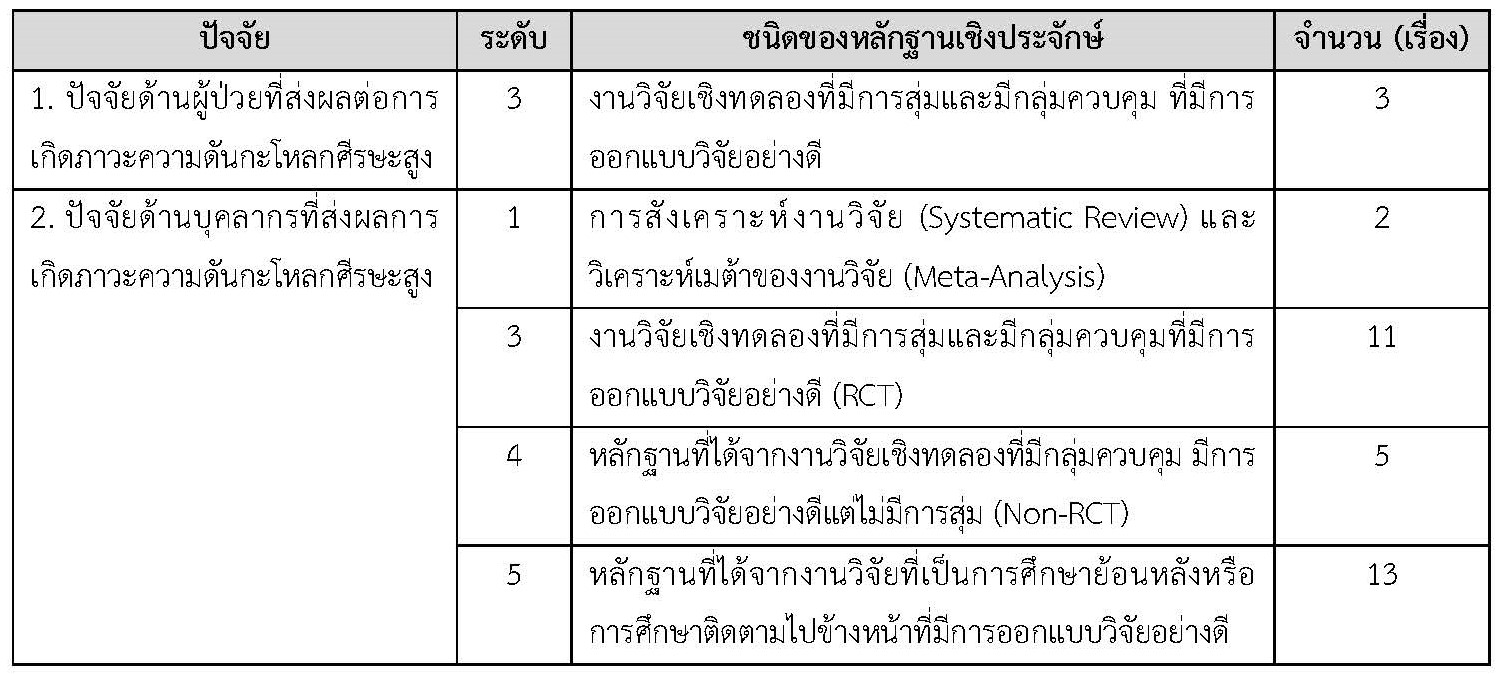การพัฒนาแนวปฏิบัติการพยาบาลทางคลินิกเพื่อป้องกันและลดภาวะความดันในกะโหลกศีรษะสูงในผู้ป่วยบาดเจ็บที่สมอง: การใช้หลักฐานเชิงประจักษ์
คำสำคัญ:
ผู้ป่วยบาดเจ็บที่สมอง, ความดันกะโหลกศีรษะสูง, แนวปฏิบัติการพยาบาลทางคลินิกบทคัดย่อ
บทความนี้มีวัตถุประสงค์เพื่อเสนอแนวปฏิบัติการพยาบาลทางคลินิกเพื่อป้องกันและลดภาวะความดันในกะโหลกศีรษะสูงในผู้ป่วยบาดเจ็บที่สมอง โดยใช้หลักฐานเชิงประจักษ์ แนวปฏิบัติการพยาบาลทางคลินิก เพื่อป้องกันและลดภาวะความดันกะโหลกศีรษะสูงในผู้ป่วยบาดเจ็บที่สมอง ประกอบด้วย 8 องค์ประกอบ ได้แก่ 1) ชื่อแนวปฏิบัติการพยาบาล 2) แนวทางปฏิบัติฯ พร้อมแหล่งอ้างอิงทางบรรณานุกรม เช่น การประเมินและติดตามค่าความในกะโหลกศีรษะผู้ป่วยบาดเจ็บที่สมอง การดูแลให้มีการระบายอากาศได้อย่างมีประสิทธิภาพการเพิ่มการไหลกลับของเลือดดำจากสมอง การจัดการสาเหตุทำให้เกิดความดันในช่องอกและช่องท้องมากขึ้น และการติดตามผลการตรวจทางห้องปฏิบัติการที่สะท้อนถึงแนวโน้มการเกิดความดันกะโหลกศีรษะสูงในผู้ป่วยบาดเจ็บที่สมอง เป็นต้น 3) ขอบเขตในการนำแนวปฏิบัติฯ ไปใช้ ประกอบด้วย พยาบาลและนักศึกษาพยาบาล เป็นต้น 4) วิธีดำเนินการ ได้แก่ การชี้แจงในที่ประชุมและการนำเสนอเพื่อชี้แจงวัตถุประสงค์ของการใช้แนวปฏิบัติฯ เป็นต้น 5) ข้อเสนอแนะ ได้แก่ การถ่ายทอดหรือการนำลงสู่ภาคปฏิบัติ ความเป็นไปได้ และความคุ้มทุน 6) หลักฐานที่ใช้ในการสนับสนุนข้อเสนอแนะ ได้แก่ การประเมินความสามารถในการใช้แนวปฏิบัติฯ และการประเมินความเป็นไปได้ของการใช้แนวปฏิบัติฯ 7) ประโยชน์และอันตรายที่อาจจะเกิดขึ้นจากการนำข้อเสนอแนะจากแนวปฏิบัติฯ ไปใช้ ได้แก่ ประโยชน์ต่อผู้ป่วยบาดเจ็บที่สมอง พยาบาลและนักศึกษาพยาบาล และหน่วยงาน และ 8) การนำแนวปฏิบัติฯ ไปใช้ในการฝึกปฏิบัติทักษะทางการพยาบาลในคลินิก ดังนั้นการใช้แนวปฏิบัติการพยาบาลทางคลินิกเพื่อป้องกันและลดคภาวะความดันในกะโหลกศีรษะสูงจึงเป็นแนวทางสำหรับพยาบาลหรือบุคลากรทางสุขภาพ ส่งผลทำให้คุณภาพการดูแลและผลลัพธ์ทางคลินิกผู้ป่วยบาดเจ็บที่สมองดีขึ้น
เอกสารอ้างอิง
ฉัตรกมล ประจวบลาภ. (2561). ภาวะความดันในกะโหลกศีรษะสูงในผู้ป่วยที่มีพยาธิสภาพที่สมอง: มิติของการพยาบาลตามหลักฐานเชิงประจักษ์. วาสารสภาการพยาบาล, 33(2), 15-28.
นิตยา กออิสรานุภาพ, วรรวิษา สำราญเนตร และวรันณ์ธร โพธารินทร์. (2566). ประสบการณ์การเรียนรู้ของ นักศึกษาพยาบาลจากการฝึกปฏิบัติการพยาบาลผู้ป่วยวิกฤต. วารสารศูนย์อนามัยที่ 9: วารสารส่งเสริม สุขภาพและอนามัยสิ่งแวดล้อม, 17(2), 453-464.
รุ่งนภา เขียวชะอ่ำ. (2556). การปฏิบัติการพยาบาลตามหลักฐานเชิงประจักษ์ (Evidence-Based Nursing).วารสารวิทยาลัยพยาบาลพระปกเกล้า จันทบุรี, 24(2), 94-108.
Altun Uğraş, G., Yüksel, S., Temiz, Z., Eroğlu, S., Şirin, K., & Turan, Y. (2018). Effects of different head-of-bed elevations and body positions on intracranial pressure and cerebral perfusion pressure in neurosurgical patients. The Journal of Neuroscience Nursing: Journal of the American Association of Neuroscience Nurses, 50(4), 247-251. https://doi.org/10.1097/JNN.0000000000000386
Arbesman, M., Scheer, J., & Lieberman, D. (2008). Using AOTA’s Critically Appraised Topic (CAT) and Critically Appraised Paper (CAP) series to link evidence to practice. OT Practice, 13(5), 18-22.
Bernard, F., Barsan, W., Diaz-Arrastia, R., Merck, L. H., Yeatts, S., & Shutter, L. A. (2022). Brain Oxygen Optimization in Severe Traumatic Brain Injury (BOOST-3): A multicentre, randomised, blinded-endpoint, comparative effectiveness study of brain tissue oxygen and intracranial pressure monitoring versus intracranial pressure alone. BMJ Open, 12(3), e060188. https://doi.org/10.1136/bmjopen-2021-060188
Canac, N., Jalaleddini, K., Thorpe, S. G., Thibeault, C. M., & Hamilton, R. B. (2020). Pathophysiology of intracranial hypertension and noninvasive intracranial pressure monitoring. Fluids and Barriers of The CNS, 17, 1-21. https://doi.org/10.1186/s12987-020 00201-8
Cooper, D. J., et al. (2018). Effect of early sustained prophylactic hypothermia on neurologic outcomes among patients with severe traumatic brain injury: The POLAR randomized clinical trial. The Journal of the American Medical Association, 320(21), 2211-2220. https://doi.org/10.1001/jama.2018.17075
Coverdale, J. P., Katundu, K. G., Sobczak, A. I., Arya, S., Blindauer, C. A., & Stewart, A. J. (2018). Ischemia-modified albumin: Crosstalk between fatty acid and cobalt binding. Prostaglandins, Leukotrienes and Essential Fatty Acids, 135, 147-157. https://doi.org/10.1016/j.plefa.2018.07.014
Craig, J. V., & Smyth, R. L. (2002). The evidence-based practice manual for nurses. Edinburgh, Scotland: Churchill Livingstone.
De Almeida, C. M., Pollo, C. F., & Meneguin, S. (2019). Nursing interventions for patients with intracranial hypertension: Integrative literature review. Aqiochan, 19(4), e1949. https://doi.org/10.5294/aqui.2019.19.4.9
Fargen, K. M., Hoh, B. L., Neal, D., O’connor, T., Rivera-Zengotita, M., & Murad, G. J. (2016). The burden and risk factors of ventriculostomy occlusion in a high-volume cerebrovascular practice: Results of an ongoing prospective database. Journal of Neurosurgery, 124(6), 1805-1812. https://doi.org/10.3171/2015.5.JNS15299
Gemma, M., Tommasino, C., Cerri, M., Giannotti, A., Piazzi, B., & Borghi, T. (2002). Intracranial effects of endotracheal suctioning in the acute phase of head injury. Journal of Neurosurgical Anesthesiology, 14(1), 50-54. https://doi.org/10.1097/00008506-200201000-00010
Griffiths, H. & Gallimore, D. (2005). Positioning critically ill patients in hospital. Nursing Standard, 19(42), 56-64. https://doi.org/10.7748/ns2005.06.19.42.56.c3902
Harrois, A., et al. (2020). Effects of routine position changes and tracheal suctioning on intracranial pressure in traumatic brain injury patients. Journal of Neurotrauma, 37(20), 2227-2233. https://doi.org/10.1089/neu.2019.6873
Hickey, J. V. (2009). The clinical practice of neurological & neurosurgical nursing.6th ed. Wolters Kluwer Health/ Lippincott Williams & Wilkins.
Hickey, J. V. & Strayer, A. L. (2020). The clinical practice of neurological and neurosurgical nursing (8th ed.) China: Philadelphia: Wolters Kluwer.
Maas, A. I. R., et al. (2022). Traumatic brain injury: Progress and challenges in prevention, clinical care, and research. The Lancet Neurology, 21(11), 1004-1060. https://doi.org/10.1016/S1474-4422(22)00309-X
Melnyk, B. M. & Fineout-Overholt, E. (2002). Key steps in implementing evidence-based practice: Asking compelling, searchable questions and searching for the best evidence. Pediatric Nursing, 28(3), 262-266.
Nyholm, L., Steffansson, E., Fröjd, C., & Enblad, P. (2014). Secondary insults related to nursing interventions in neurointensive care: A descriptive pilot study. Journal of Neuroscience Nursing, 46(5), 285-291. https://doi.org/10.1097/JNN.0000000000000077
Pinto, V. L., Tadi, P., & Adeyinka, A. (2023). Increased Intracranial Pressure. In StatPearls. StatPearls Publishing.
Qu, X., et al. (2021). Targeted temperature management at 33 degrees celsius in patients with high-grade aneurysmal subarachnoid hemorrhage: A protocol for a multicenter randomized controlled study. Annals of Translational Medicine, 9(7), 581. https://doi.org/10.21037/atm-20-4719
Radwan, T. A., et al. (2021). Ischemia-modified albumin as a biomarker for prediction of poor outcome in patients with traumatic brain injury: An observational cohort study. Journal of Neurosurgical Anesthesiology, 33(3), 254-257. https://doi.org/10.1097/ANA.0000000000000647
Rienecker, C., Kiprillis, N., Jarden, R., & Connell, C. (2022). Effectiveness of interventions to reduce ventriculostomy-associated infections in adult and paediatric patients with an external ventricular drain: A systematic review. Australian Critical Care, 36(4), 650-668. https://doi.org/10.1016/j.aucc.2022.03.013
Schizodimos, T., Soulountsi, V., Iasonidou, C., & Kapravelos, N. (2020). An overview of management of intracranial hypertension in the intensive care unit. Journal of Anesthesia, 34(5), 741–757. https://doi.org/10.1007/s00540-020-02795-7
Smyth, R. L. (2011). Evidence-based practice manual for nurses-e-book: With pageburst online access. Elsevier Health Sciences.
Szabo, C. M., Grap, M. J., Munro, C. L., Starkweather, A., & Merchant, R. E. (2014). The effect of oral care on intracranial pressure in critically ill adults. Journal of the American Association of Neuroscience Nurses, 46(6), 321-329. https://doi.org/10.1097/JNN.0000000000000092
Tokutomi, T., Morimoto, K., Miyagi, T., Yamaguchi, S., Ishikawa, K., & Shigemori, M. (2003). Optimal temperature for the management of severe traumatic brain injury: Effect of hypothermia on intracranial pressure, systemic and intracranial hemodynamic and metabolism. Neurosurgery, 52(1), 102-112.
The Joanna Briggs Institute. (2000). Best practice: Evidence based practice information sheets for health professionals, Reproducido Del Best Practice, 4(2), 1-6.
Titler, M. G., et al. (2001). The IOWA model of evidence-based practice to promote quality care. Critical Care Nursing Clinics of North America, 13(4), 497-509. https://doi.org/10.1016/S0899-5885(18)30017-0
van den Berghe, G., et al. (2001). Intensive insulin therapy in critically ill patients. The New England Journal of Medicine, 345(19), 1359-1367. https://doi.org/10.1056/NEJMoa011300
Vieira, T. W., Sakamoto, V. T. M., Araujo, B. R., Pai, D. D., Blatt, C. R., & Caregnato, R. C. A. (2022). External ventricular drains: Development and evaluation of a nursing clinical practice guideline. Nursing Reports, 12(4), 933-944. https://doi.org/10.3390/nursrep12040090
Wallace, E., Sharkey, N., & Kerr, E. (2020). Critical care neurology for junior doctors; Four key management strategies. The Ulster Medical Journal, 89(1), 11-13.
Wu, M., et al. (2020). Effects of propofol on intracranial pressure and prognosis in patients with severe brain diseases undergoing endotracheal suctioning. BMC Neurology, 20(1), 394. https://doi.org/10.1186/s12883-020-01972-1

ดาวน์โหลด
เผยแพร่แล้ว
รูปแบบการอ้างอิง
ฉบับ
ประเภทบทความ
สัญญาอนุญาต
ลิขสิทธิ์ (c) 2024 วารสารวิจัยการพยาบาลและการสาธารณสุข

อนุญาตภายใต้เงื่อนไข Creative Commons Attribution-NonCommercial-NoDerivatives 4.0 International License.
1. บทความหรือข้อคิดเห็นใด ๆ ที่ปรากฏในวารสารวิจัยการพยาบาลและการสาธารณสุข ที่เป็นวรรณกรรมของผู้เขียน บรรณาธิการไม่จำเป็นต้องเห็นด้วย
2. บทความที่ได้รับการตีพิมพ์ถือเป็นลิขสิทธิ์ของ วารสารวิจัยการพยาบาลและการสาธารณสุข








